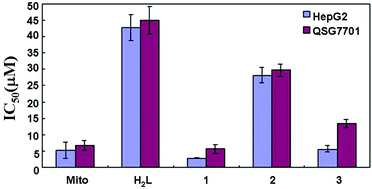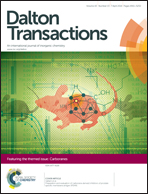Main group bismuth(iii), gallium(iii) and diorganotin(iv) complexes derived from bis(2-acetylpyrazine)thiocarbonohydrazone: synthesis, crystal structures and biological evaluation†
Abstract
Up to now, the metal complexes with thiocarbonohydrazones have been comparatively rare. Herein, three main group monometallic complexes formulated as [Bi(HL)(NO3)2(H2O)] (1), [Ga(HL)2]OAc·EtOH (2) and [(Ph)2Sn(HL)(OAc)]·DMF (3), where H2L = bis(2-acetylpyrazine)thiocarbonohydrazone, have been synthesized and characterized. The crystal structures of complexes 2 and 3 have been determined by single-crystal X-ray diffraction. Growth inhibition assays have indicated that both the free ligand and the title complexes are capable of inhibiting cell proliferation growth and could slightly distinguish the human hepatocellular carcinoma HepG2 cells from normal hepatocyte QSG7701 cells. Of particular note is the fact that the bismuth(III) complex 1 is the most active compound of this study and is 14-fold more cytotoxic than H2L with an IC50 value of 2.96 ± 0.25 μM. Its possible apoptotic mechanism has been evaluated in HepG2 cells. Complex 1 promotes a dose-dependent apoptosis in HepG2 cells and the apoptosis is associated with an increase in intracellular reactive oxygen species (ROS) production and reduction of mitochondrial membrane potential (MMP).


 Please wait while we load your content...
Please wait while we load your content...